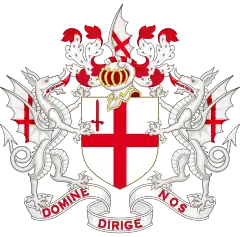 | |
| Location | London, England |
|---|---|
| Postal code | EC3 |
| North end | Eastcheap |
| South end | Pedestrianised to Lower Thames Street |
| Other | |
| Known for | Origin of the Great Fire of London |
Pudding Lane is a small street in London, widely known as the location of Thomas Farriner's bakery, where the Great Fire of London started in 1666. It runs between Eastcheap and Thames Street in the historic City of London, and intersects Monument Street, the site of Christopher Wren's Monument to the Great Fire.
Farriner's bakery stood immediately opposite the Monument, on the eastern side of Pudding Lane. The site was paved over when Monument Street was built in 1886–87, but is marked by a plaque on the wall of nearby Farynors House, placed there by the Bakers' Company in 1986.[1]
Pudding Lane was given its name by the butchers of Eastcheap Market, who used it to transport "pudding" or offal down to the river to be taken away by waste barges. There was a wharf at its lower end called Rothersgate (from the "rothers" or cattle that were landed there), and it was also known as Rother Lane.[2] Another name for it was Red Rose Lane, from a shop sign that once hung in it.[3]
Pudding Lane was one of the world's first one-way streets.[4] An order restricting cart traffic to one-way travel on Pudding Lane and 16 other lanes around Thames Street was issued in 1617, an idea not copied until Albemarle Street became a one-way street in 1800.
The nearest Underground station to Pudding Lane is Monument, a short distance to the west. The closest main-line railway stations are Fenchurch Street and Cannon Street.
In popular culture
Tom Canty, the protagonist of Mark Twain's The Prince and the Pauper, lives on Pudding Lane.
Sara Addington was the author of some children's books referring to the lane:
- The Boy Who Lived in Pudding Lane. Illustrated by Gertrude Alice Kay. Boston: Atlantic Monthly Press, 1922.
- Pied Piper of Pudding Lane. Illustrated by Gertrude Alice Kay. Boston: Atlantic Monthly Press, 1923. OCLC 17400199
- Round the Year in Pudding Lane. Illustrated by Gertrude Alice Kay. Boston: Little, Brown, and Company, 1924. OCLC 6579353
- Pudding Lane People. Illustrated by Janet Laura Scott. Boston: Little, Brown, and Company, 1926. OCLC 11418973
Pudding Lane and Farriner's bakery feature prominently in the 2016 musical show Bumblescratch.[5]
In the 1982 Doctor Who episode "The Visitation", aliens visit 17th century London and cause an explosion in Pudding Lane, which is revealed to be the true source of the Great Fire.
References
- ↑ Gerhold, Dorian (2015). "Where did the Great Fire begin?" (PDF). London and Middlesex Archaeological Society Transactions. 66: 1–7.
- ↑ Mills, David (2010). A Dictionary of London Place-Names. Oxford: The University Press. ISBN 9780199566785.
- ↑ Stow, John (1908). "Billinsgate warde". In Kingsford, Charles (ed.). A Survey of London. Reprinted From the Text of 1603. Oxford: Clarendon Press.
- ↑ "One-way streets are a surprisingly old (and dangerous) idea". The Spectator. 2 May 2015. Retrieved 14 December 2018.
- ↑ Bumblescratch: Adelphi Programme "Synopsis", pp. 23–24, (September 4, 2016)
Bibliography
- Collins, Amy (2016). "Pudding Lane". Map of Early Modern London. University of Victoria. Retrieved 16 December 2018.
